Why You Don't Have To Wait That Long For Baked Potatoes At A Restaurant
Baked potatoes are a staple meal at restaurants. However, a baked potato requires, well, baking. As with other baked goods, baking potatoes takes time, so one might wonder how a restaurant manages to serve baked potatoes to customers when they order them.
This isn't a new phenomenon. In nineteenth-century Britain, baked potato sellers became a fixed part of London's street scene. They effectively served the purpose of hot dog or halal carts for the people who could not afford the time to cook, especially not dishes as time-intensive as a baked potato.
According to A History of English Food by Clarissa Dickson Wright, these baked potato vendors made deals with friendly local bakers. They used the baker's oven to bake batches of around 75 potatoes. After ensuring they had a large stock prepared, the vendors then kept the baked potatoes in large heated tin boxes that were known as potato cans.
Pre-made meals remain popular in food service
Technology may have changed since the nineteenth century, but the basic practice hasn't. According to Restaurant Ninjas, restaurants that serve baked potatoes bake their potatoes in advance and keep them in warming equipment. Moreover, there is a constant cycle of new potatoes going out to ensure the food is fresh.
This might sound familiar. In Anthony Bourdain's breakout book Kitchen Confidential, he made a similar comment about hollandaise sauce and brunch. An extract shared with The Guardian reads, "Brunch menus are an open invitation to the cost-conscious chef, a dumping ground for the odd bits left over from Friday and Saturday nights. How about hollandaise sauce? Not for me. Bacteria love hollandaise. And nobody I know has ever made hollandaise to order."
Now, the baked potatoes may not offer as much free bacterial real estate as hollandaise sauce, but the point is that restaurants prize efficiency. So, Restaurant Ninja unpacks the efficiency of baked potatoes. Before the week even begins, the amount of potatoes per hour is decided upon. These are then set up on baker racks the evening before. One person then gets the job of shoving those racks in the oven to bake. Any leftovers can be made into potato skins and soup.

